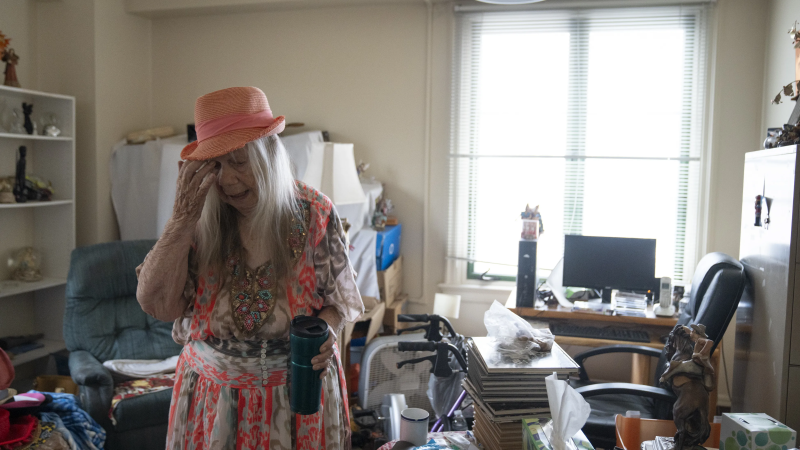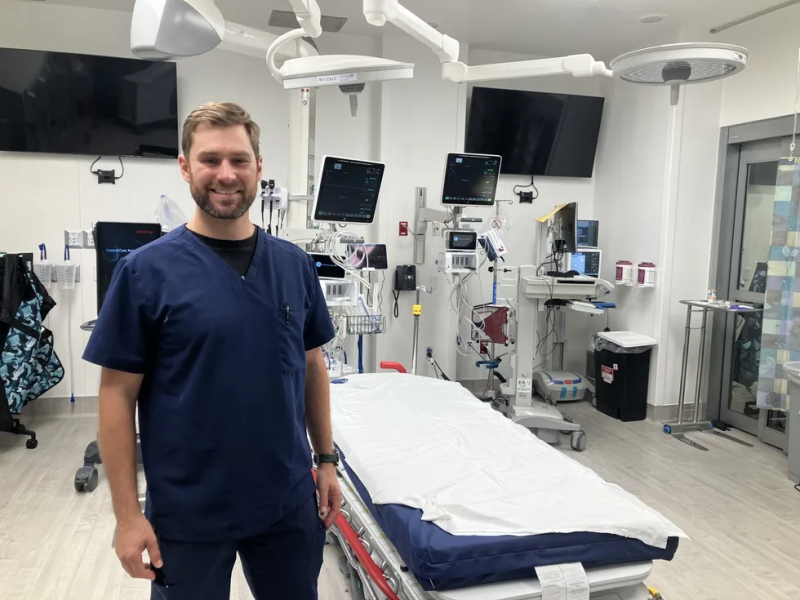When heat hurts: ER doctors treat heatstroke, contact burns on Phoenix's hottest days
In a central Phoenix emergency room, nurse Mindy Turner picked up a ringing phone.
It was a Friday afternoon in July, another hot weekend beckoning. But at Valleywise hospital on east Roosevelt Street, it was time for the next shift.
Turner listened as a paramedic recited vital signs for the patient they were about to bring in. Behind her, the day shift doctors and nurses handed off to the evening staff. The hospital around them was new since June. Trauma rooms, where patients suffering heatstroke are regularly plunged into bags of ice, waited empty, for now.
It was 3:30 p.m., peak time for heat admissions. Outside, it was 107 degrees.
The phone rang again.
All paramedic courtesy calls go through this line, whether the patients are headed to the ER or the Arizona Burn Center upstairs. Summer places stress on both departments, but on this particular Friday, it was the burn center groaning with admissions.
“Today, they’ve had quite a few,” Turner said, during a rare, brief lull. “It’s been call after call.”
A Southwest summer problem
Heat kills. In 2023, 645 people died in Maricopa County, which encompasses metropolitan Phoenix, from causes related to heat. As of two weeks ago, public health officials had confirmed 114 heat-related deaths this year and were investigating another 465. Those who don’t make it through summer are often vulnerable: elderly, unhoused, dealing with substance abuse or existing health conditions.
But if the temperature is high enough, the exposure long enough and the respite too late, anyone can succumb.
Sometimes, help arrives just in time. That’s when people end up in the hospital, carrying serious injuries that might require intubation, or multiple surgeries, or a new heatstroke treatment involving a body bag full of ice.
On Friday afternoon, burn surgeon Louis Ferrari was preparing to head to the operating room.
Dressed in purple scrubs and blue caps, Ferrari and his colleagues had 12 surgeries on the list that day. They were just over halfway through.
A specific type of injury is keeping them busy, one relatively unique to a Southwest summer: contact burns.
As the sun moves in a long arc across Phoenix, it pours solar energy into the concrete that carpets the city. Pavement and asphalt absorb the heat, radiating it long after the sun goes down, contributing to overnight lows that, in most American cities, would look more like uncomfortable highs.
It also makes these urban surfaces far hotter than the ambient air temperature. Outdoors, 100 degrees might feel like stepping into an oven, but the asphalt, which can hit 160 degrees at that temperature, burns like one.
A third-degree burn can occur in less than a minute. Such contact burns are increasingly common in Phoenix, America's hottest big city, which in July recorded an average temperature, over 24 hours, of 101.1 degrees.
It happens to the elderly, frail person who falls and cannot get back up. To people struggling with substance abuse who slip into a fentanyl-induced stupor on the pavement. It happened to someone with neuropathy in their feet from diabetes who could not feel her soles burning as she walked. To someone who fell forward, burned on their front, and was then rolled over by a well-meaning bystander, burning the back of their body too.

Contact burn patients often also have heatstroke, Ferrari said. Their core temperature is so far past normal that their organs began to shut down.
“Kidneys. Livers. Brains. Lungs. They start to fail,” Ferrari said. “You add to that a 30%, a 40% burn. You get a very sick person.”
He fielded a quick call. Time to head downstairs. Another contact burn patient.
“What we often face here can be overwhelming, because this just keeps happening,” he said, after hanging up. “Every day.”
This year, for reasons nobody is quite sure of, has been particularly bad.
“Arpana, compared to last year we're working harder, yeah?” Ferrari said, as he left.
Arpana Jain, also a burn surgeon, leaned out of her office. “Oh my god, yeah,” she said.
Jain was on clinic duty Friday, after a frenetic week in which she had done 19 surgeries across four consecutive days. That kind of volume is rare, she said, close to double what she might normally perform.
Summer also brings burns from grills, campfires and other recreational mishaps, but it’s contact burns putting the burn center under stress.
When a patient is admitted, it’s a race against the clock. The faster burned tissue is removed, the better the chances of a fast and uncomplicated healing process. But it’s tough in summer, when caseload exceeds capacity.
“We are just barely getting by,” Jain said.
Space is also a problem. Each percentage of the body burned translates to about a day in hospital, and beds fill fast. The center has recently started doing outpatient surgeries, where certain patients are asked if they would be comfortable going home after the operation.
“Which we have never done before,” Jain said. “We had to really be careful. Who do we select for such a type of treatment? We didn’t want a change in quality.”
It works out in a limited subset of patients, those who understand the care their wounds require and have good support at home.
Jain isn’t complaining about the workload. She’d rather be a surgeon than anything else. But it’s hard to see patient after patient suffering injuries that are both avoidable and severe.
“It's life altering,” she said. “And unfortunately, some of them will succumb to it.”
Putting patients in ice
Down in the ER, Dr. Geoffrey Comp was handing over to the evening staff, his day shift almost complete.
Before he left, he stopped in a trauma room, where he and other doctors frequently administer a new heatstroke treatment.
“It’s a bit crude,” Comp said, “but we put them in a body bag full of ice water.”
It really is that simple. Patients undergo a rapid vitals check and are then zipped into a bag of ice, up to about chest height. While they’re in the bag, doctors and nurses monitor temperature and vitals, check the electrical activity of the heart and administer cooled IV fluids.
Once the patient’s temperature approaches a normal 98 degrees, they're taken out.
In the past, heatstroke treatments have been evaporative, relying on cold water and fans. But the ice bag method is faster, more responsive to the dire needs of the patients rolling into the ER.
“People are incredibly, incredibly, incredibly hot sometimes when they come in,” Comp said.
He has treated people with a body temperature of 109 degrees, and often hears from paramedics that patients exceeded the capacity of an ear thermometer.
“It’s coming up as just too hot to read,” he said.
Last summer, the ice bag showed a promising effect on mortality rates. This year, the Valleywise ER had used it around 45 times, as of late July. They work with the hospital cafeteria to ensure a constant supply of ice.
Phoenix Fire also uses the method to “pre-cool” patients on the way to hospital, which Comp said can make an enormous difference.
One day in late July, it was a tale of two patients.
One of those too-hot-to-read patients got the ice bag treatment on the way to hospital. By the time they reached Comp, they were responsive, moving, and sufficiently cooled to come out of the bag. The improvement of their mental status was “pretty incredible,” Comp said.
But the bag isn’t a miracle cure. The same day, a patient came in with a temperature of 107, even after pre-cooling in the ambulance. It took a long time for them to come down to a normal temperature, and they were then subsequently placed in a medical coma in critical condition.
“For some people, this intervention is really kind of turning them around if we’re able to catch it fast enough,” Comp said. “And for some people, unfortunately, at some point it just gets to be too hot out there.”

Just like the burn center, summer puts the ER under stress.
Someone who appears to recover quickly from heatstroke may have organ damage, in particular liver and kidney problems, which can take a while to emerge. The heat also exacerbates chronic health problems, potentially sending someone with heart disease or a lung condition to the ER when, on a milder day, they might have been OK.
Safe discharge is another consideration. No one is immune to the heat, but some are more susceptible than others, especially unhoused people who do not have a cooled space to go.
“It’s not helpful in our community if I get someone to feel better at 3:00 in the afternoon and discharge them when it's 112 outside still,” Comp said.
They have handouts pointing people to cooling centers, as well as relying on social workers and community resources like the Arizona Heat Relief network.
They don’t want to make patients better, only for the heat to make them sick again.
One week in the Phoenix heat:Living and dying in America’s hottest big city
'Hotter than it's ever been':How this 93-year-old copes with Phoenix's 100-degree heat
Measuring heatHow to do it correctly, according to scientists, and why it matters
Disclaimer: The copyright of this article belongs to the original author. Reposting this article is solely for the purpose of information dissemination and does not constitute any investment advice. If there is any infringement, please contact us immediately. We will make corrections or deletions as necessary. Thank you.






